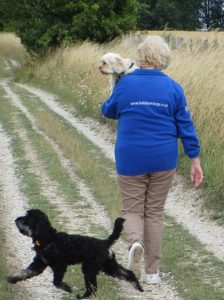Why Does My Dog Hate Walks?
The majority of dogs are more than enthusiastic about daily walks with their family. However some dogs don’t always share the same zest for the great outdoors. Does your dog love, or hate, walks? Holidays4Dogs investigates the reasons why some dogs prefer home comforts, to the call of the countryside.
There may be a variety of reasons why a dog shows a distinct lack of enthusiasm when it comes to walk time. First and foremost, if you are worried about your dog, book him into the vet for a health check. This will rule out any physical reason which might be preventing him from enjoying his walks.
Once you have ruled out any possible underlying health issues and your dog is otherwise fit, it is time to consider why else your dog prefers to be a couch potato. Certainly, some breeds of dog are less energetic than others. If you want to know which breeds often have lower energy levels, read our other article here.
Sometimes, just like people, there are times when dogs just may not feel in the mood for going out. The odd, occasional, missed walk, won’t harm.
Don’t force your dog as he, or she, may just be feeling off colour. However, if you’re dog consistently refuses to leave the house and hates walks – there could be more going on.
The fear factor.
Fear and anxiety/stress could be one reason why some dogs refuse to set foot out of the house. Socialisation is really important when you bring your new puppy home.
Thunderstorms, loud traffic, joggers, crow scarers or, prams. There are multiple stressors that may cause a dog to hate walks. Puppies, can become frightened of novel things, during their various development periods, so always try and make sure your puppy has positive new experiences.
Rescue dogs often have behavioural issues, including fears and phobias. If older dogs have not be socialised well, they may have developed fears of the world around them. As a result, this may make them feel uncomfortable when out walking, if they have to face things they are fearful of.
Dog tired.
Your dog may not actually hate walks. It could be that your dog is just plain tired. If he has already been out two, or three, times that day, he may just feel too pooped to want to go out again. Puppies, especially, should not be over exercised.
If they begin to feel uncomfortable on walks, they may show reluctance to leave the house next time. It is best to keep walks short when your dog is a puppy and understand the energy levels, and needs, of your particular breed.
Older dogs too may be reluctant to go for a walk if they feel stiff, or ache. Many old dogs suffer from arthritis and other degenerative conditions associated with growing old. It is little wonder, therefore, why some old dogs develop a distaste for walking.
Dogs that have lost their sight, or hearing, may also find negotiating walks challenging. While dogs need daily exercise, do be aware of your dog’s changing energy levels as he grows older. Shorter walks in quieter areas may suit your elderly dog much better.
Weather.
It is amazing how many dogs have no interest in setting foot out of the door when it is raining. A lot of dogs dislike cold, wet, conditions and these include toy dogs and dogs without an under/double coat. Whippets and Italian greyhounds notoriously hate walks in the rain. Snow and ice can be unpleasant for some dogs, especially when slippery. Make sure your dog is protected from the elements with a good warm coat if he, or she, is tiny or elderly.
Boredom busters.
Sometimes dogs just get bored on walks. Many owners amble along looking at their mobile phones, or listening to music on their head phones, without once engaging with their dog who follows dutifully along the pavement on the end of his lead. Dogs thrive when their brains are occupied, as well as their bodies.
If your dog cannot be let off the lead, consider purchasing a long line so he can have more freedom to investigate his environment, without loss of control. There are plenty of games and activities you can incorporate into dog walks. To get some ideas see our other article here.
Try varying the places you walk. It is amazing how many people will do the same dog walk, day after day. This can be just as tedious for the dog, as it must be for the owner. The dog may be quite unexcited by the prospect of the same old perambulation around the block.
How to help the reluctant walker.
If you feel your dog has developed a fear of the great outdoors and now hates walks, you may want to enlist the help of a trainer, or behaviourist to help you address whatever it is that is bothering him.
Importantly, never force, or drag your dog to walk – this will only create further tension and resistance. You can try using a harness, instead of a lead, which some dogs find more reassuring.
Walk only at quiet times of the day, avoiding any areas you feel may be triggering your dog’s anxiety. Start off with very short walks and use plenty of praise.
Make sure all your dog’s walking gear – collars, harness, coat – fit well. If your dog feels uncomfortable, he will be far less enthusiastic about walking in them.
Conclusion.
It can be frustrating, especially if you cannot see a reason for your dog’s lack of enthusiasm for going for a walk – particularly if you yourself, are raring to go rambling with your four-legged friend. Dogs don’t normally hate walks for a long period. There is usually an isolated reason why dogs are reluctant to explore the great outdoors.
Make things fun for your dog and, with a little time, your dog will soon be happy to accompany you on your walking adventures. Alternatively, you could always curl up on the couch together – dogs love snuggling up and idling a few hours away, just as much as we do!


